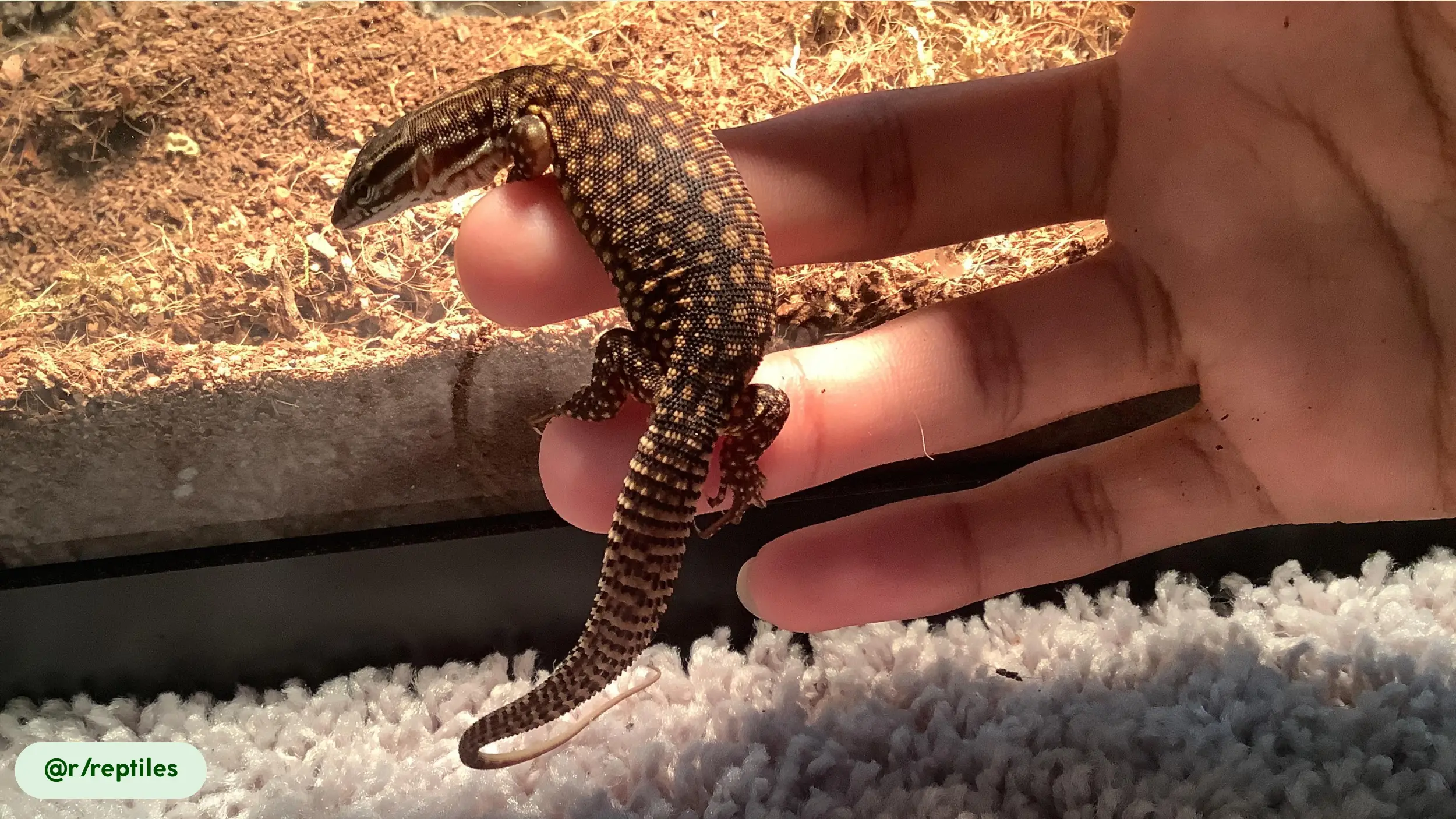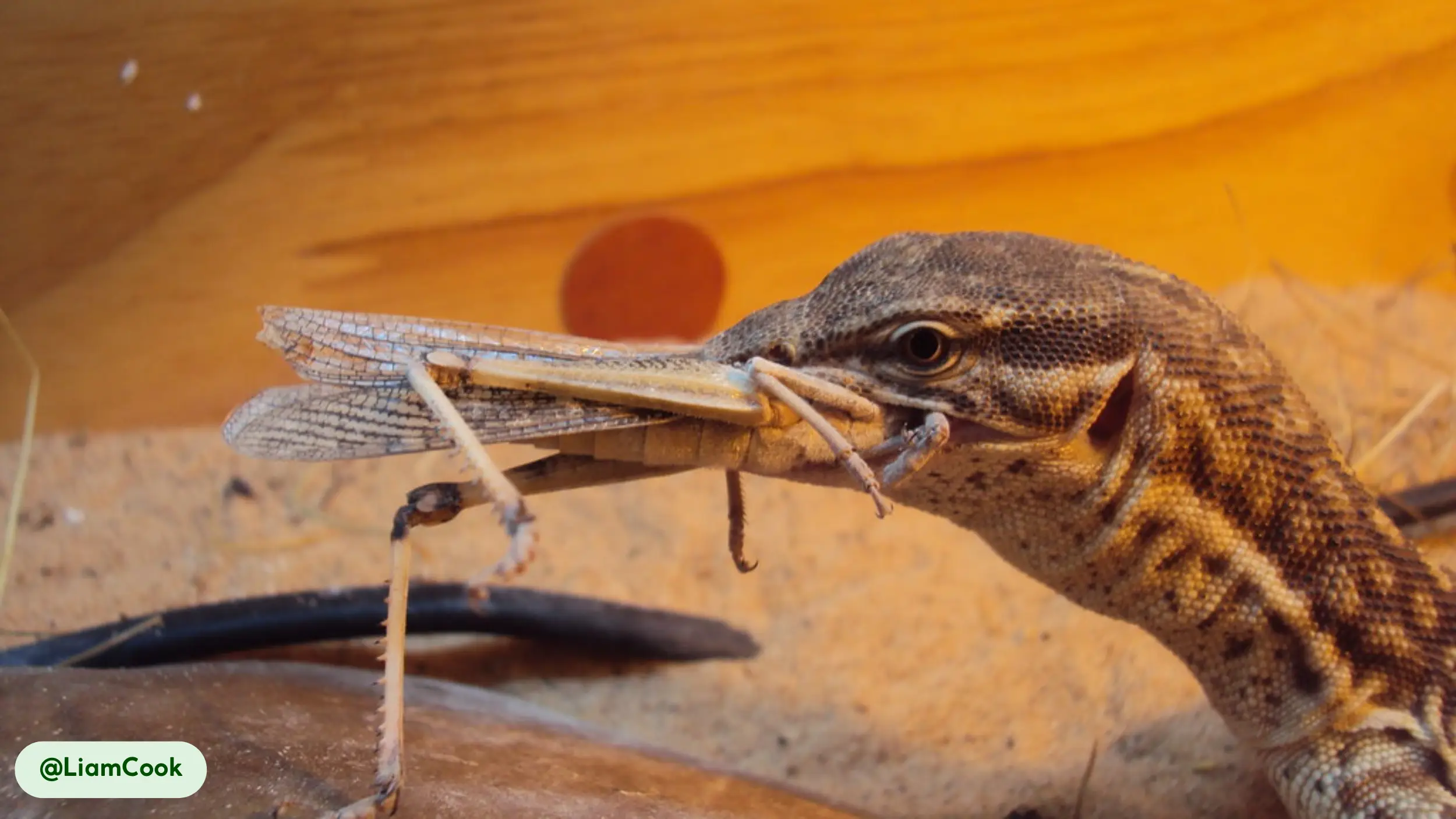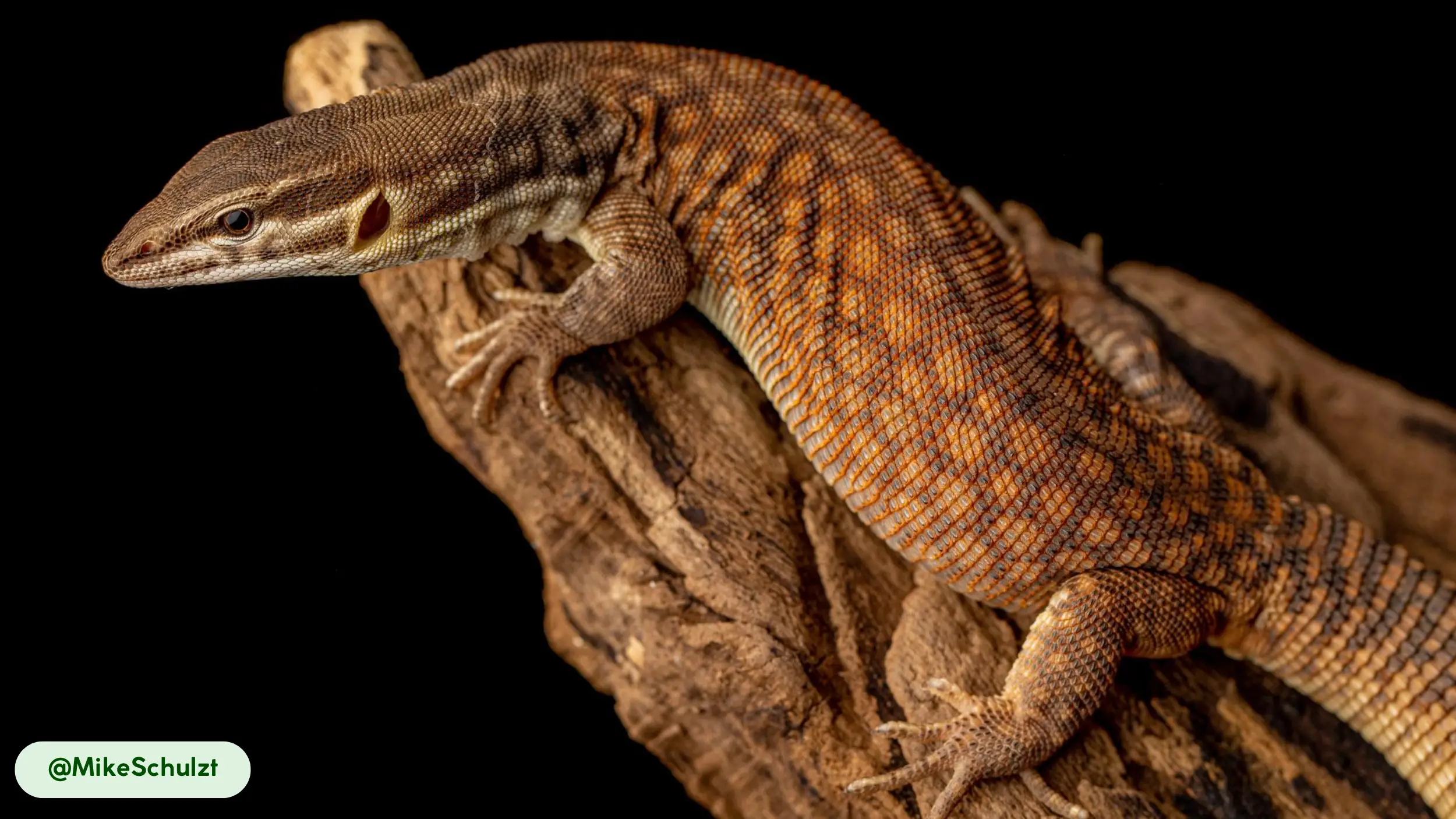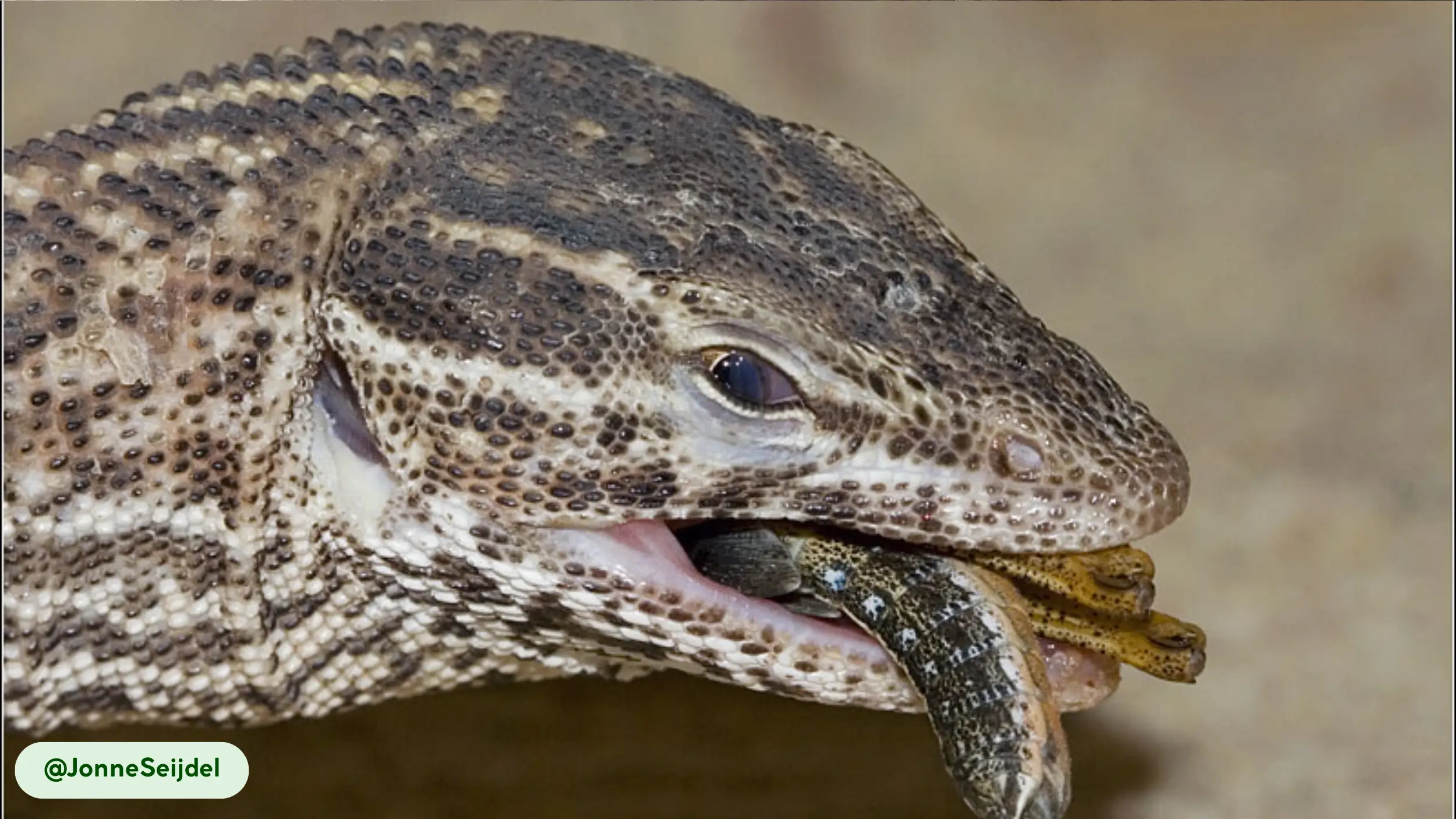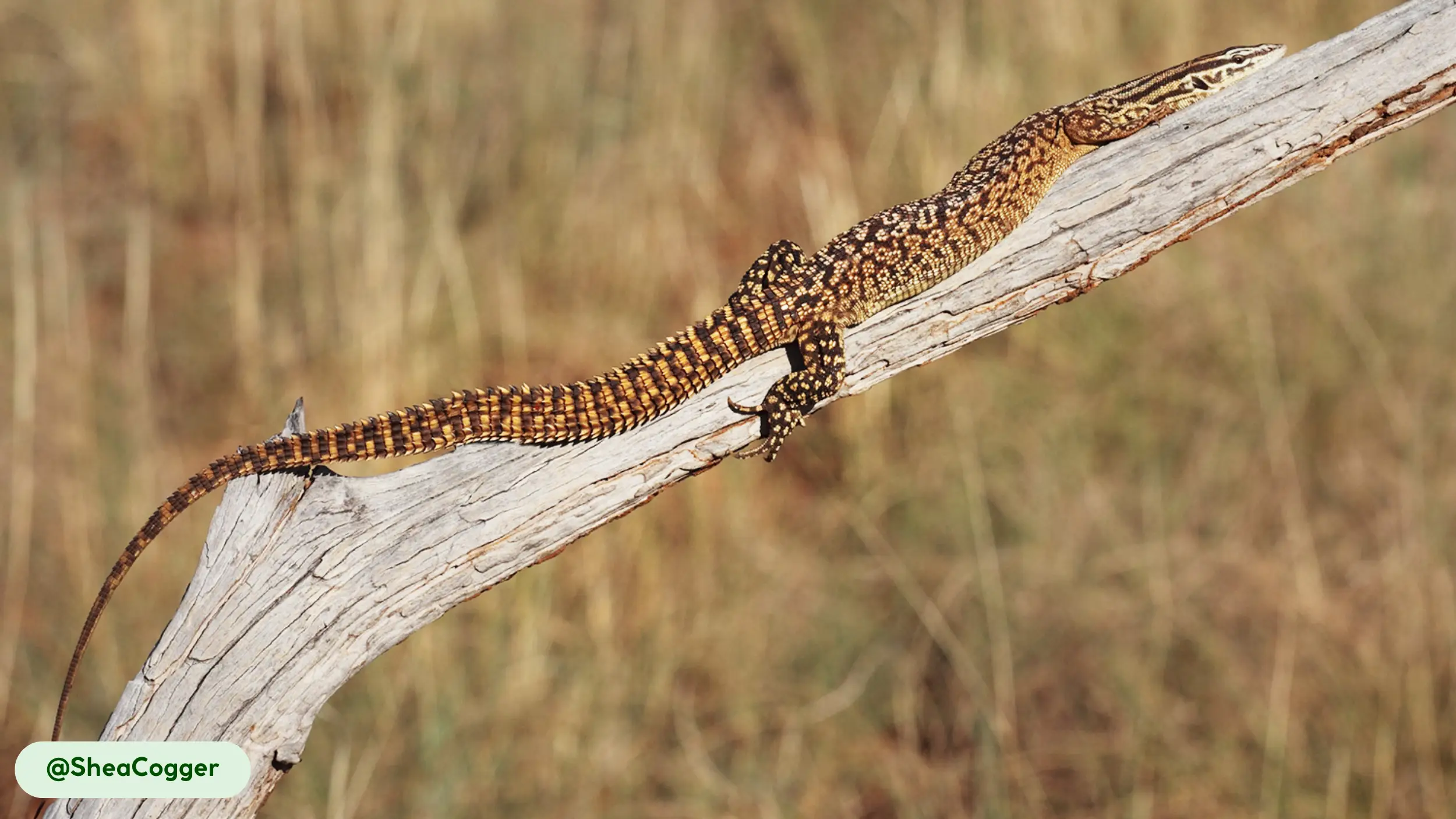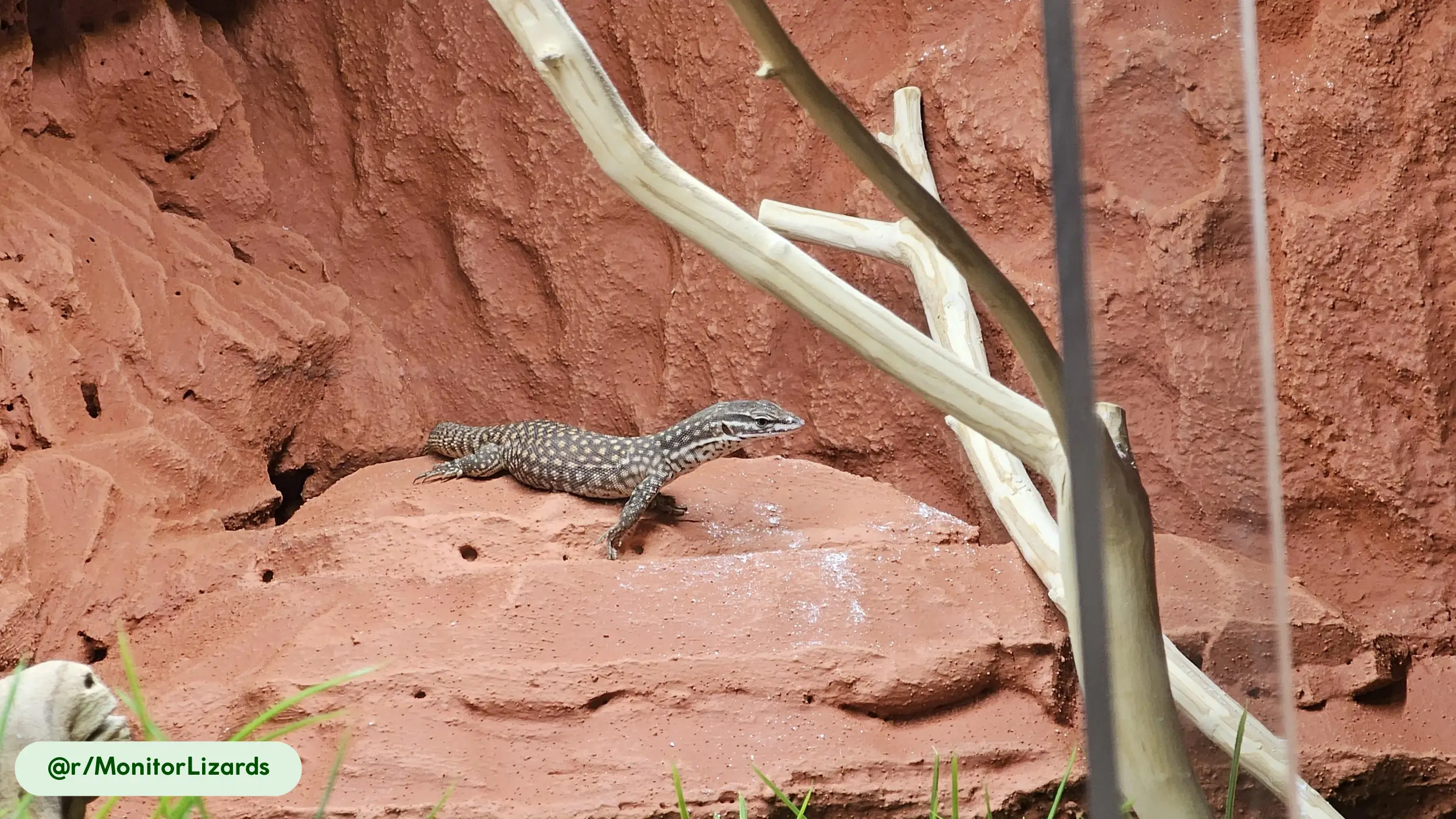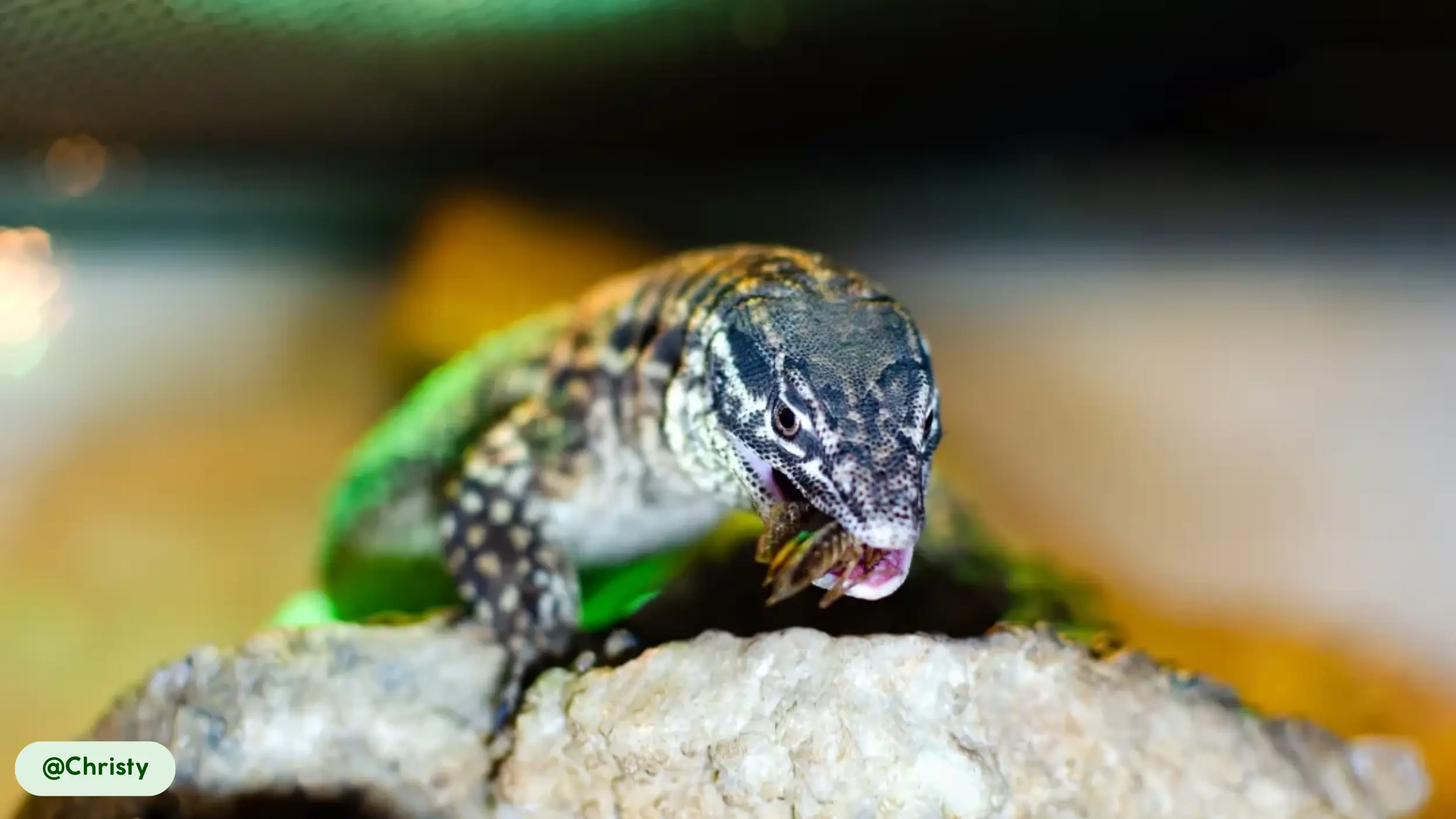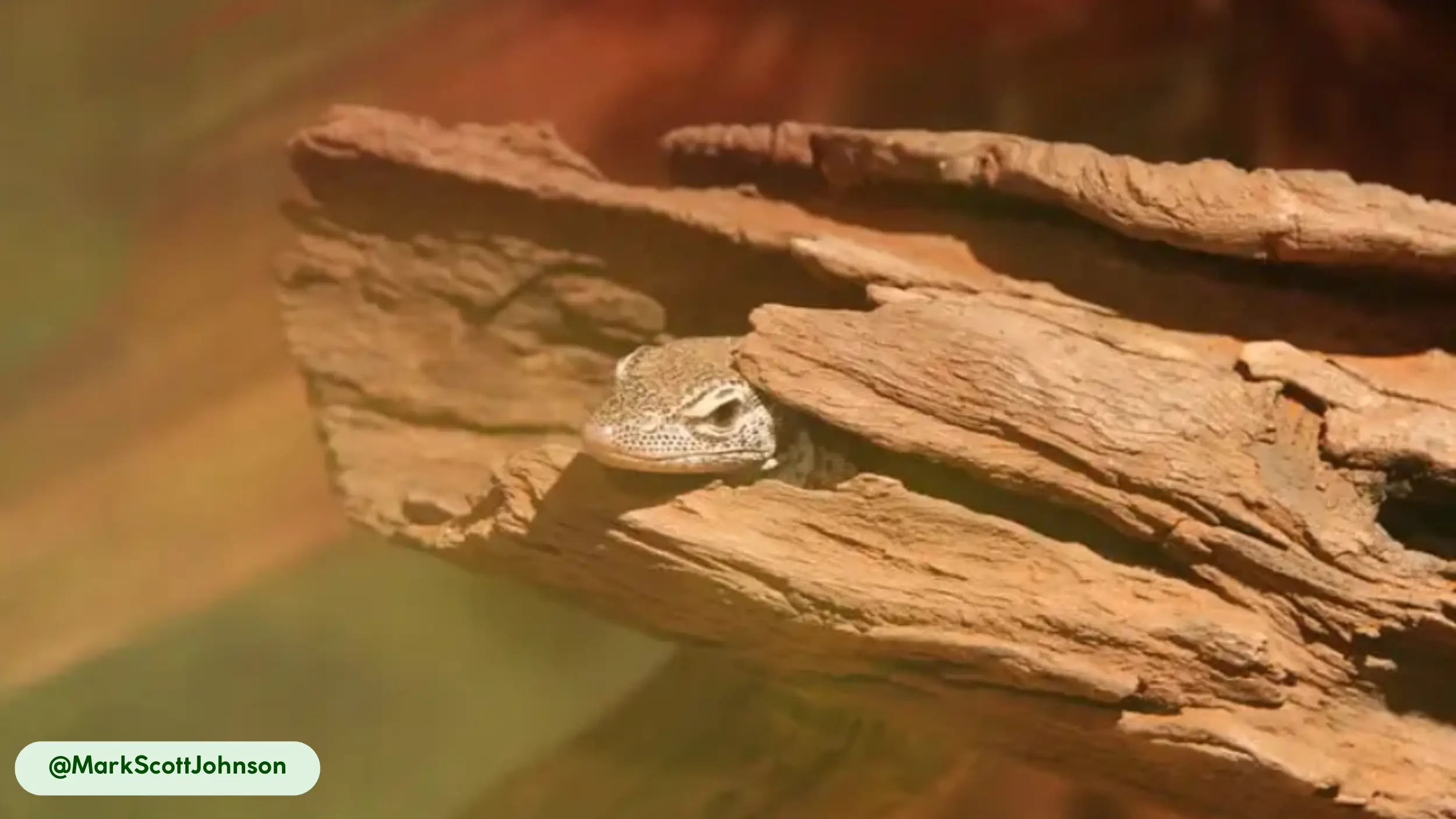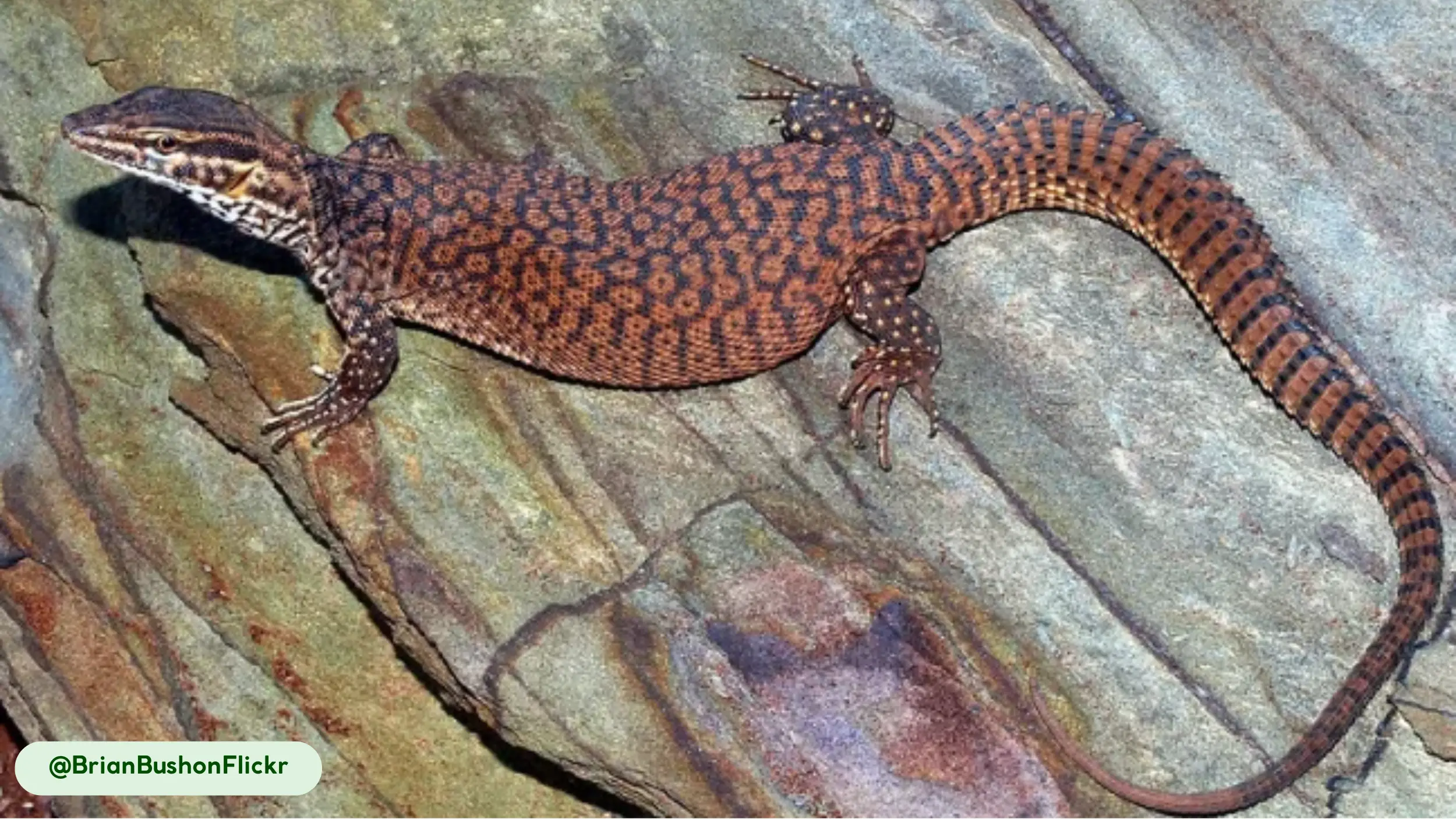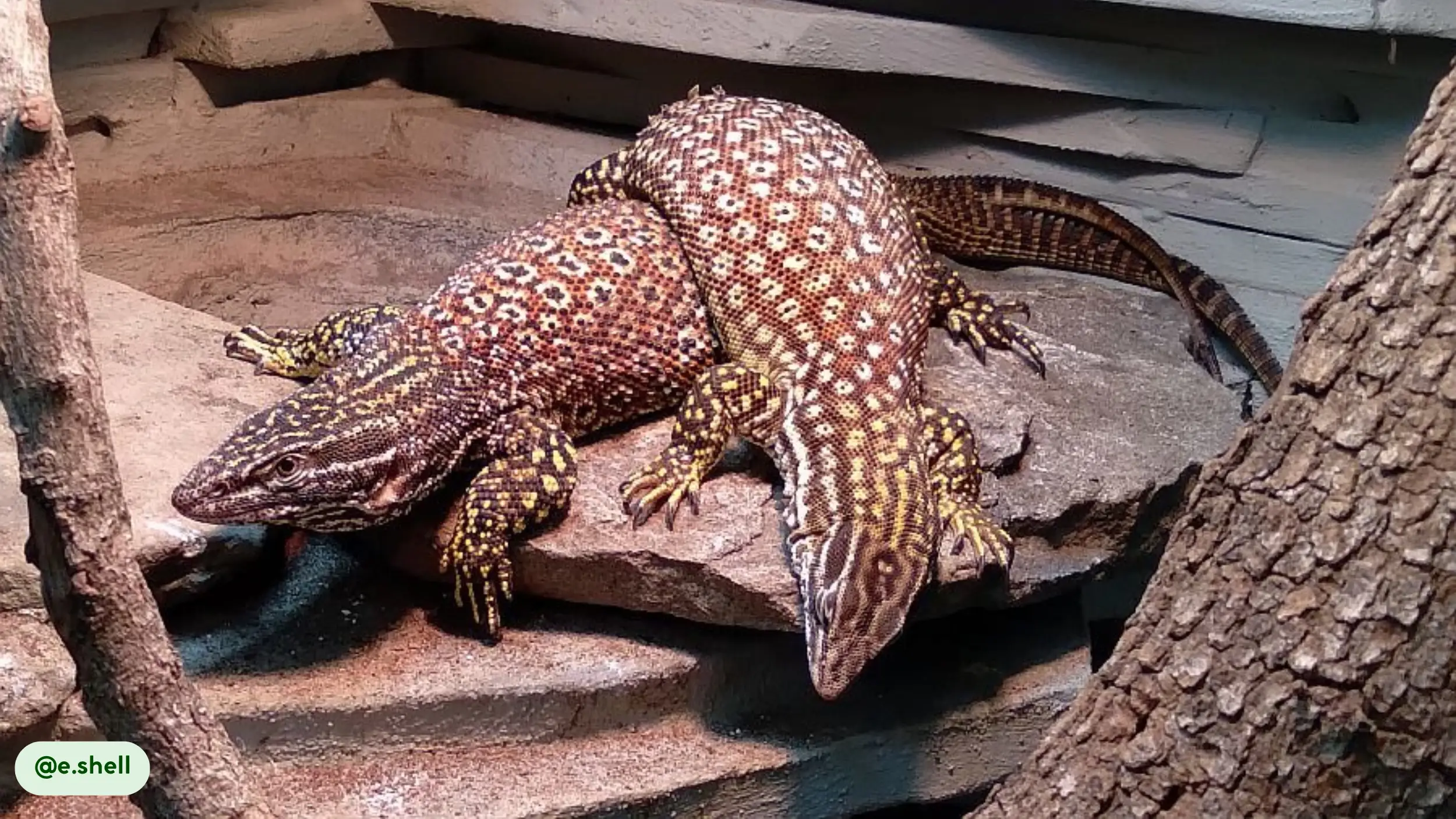The Ackie monitor (Varanus acanthurus) is a small, semi-fossorial species of monitor lizard indigenous to northern Australia. This reptile belongs to the Varanidae family within the class Reptilia. Typically reaching a length of 24-30 inches (60-75 cm), the species is an active forager, primarily feeding on insects.
Its range is confined to the arid, rocky regions of its native country, where it exhibits a unique burrowing and terrestrial lifestyle. The species is recognized as a reptile of Least Concern by the IUCN, reflecting a stable population despite some localized threats.
This comprehensive guide examines the species from a scientific perspective, providing a detailed overview of its taxonomy, unique physical characteristics, and natural history.
By exploring its classification, body structure, and ecological role, we provide an in-depth understanding of this animal. We will first provide a scientific definition of the Ackie monitor, clarifying its place in the animal kingdom and addressing the complexities of its classification.
Now that we have established its place in the animal kingdom, let’s proceed with a scientific definition of this intriguing reptile. The physical form of the Ackie monitor is a direct result of its taxonomic history and its adaptation to its arid habitat.
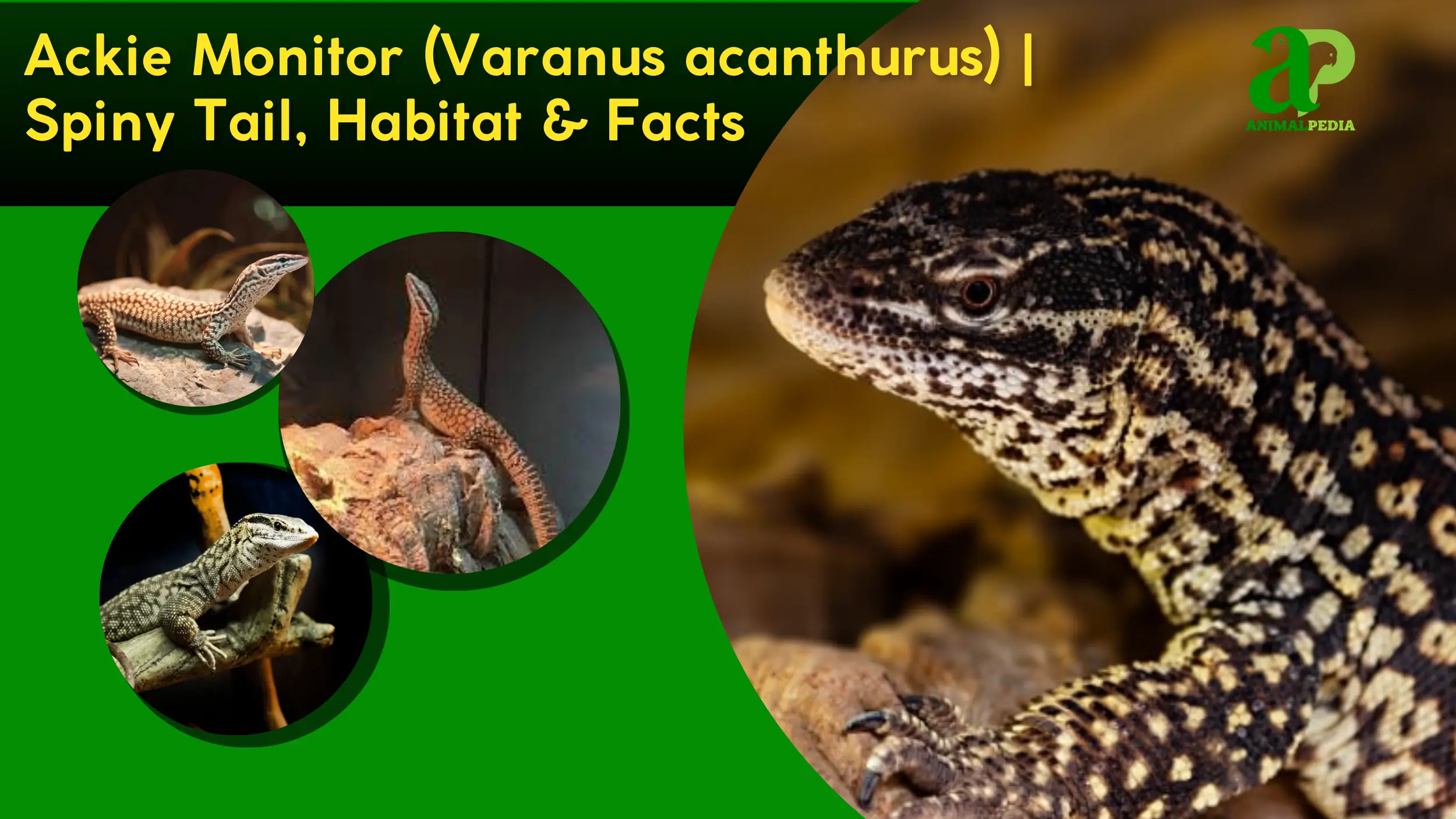
What Is Ackie Monitor?
The Ackie monitor (Varanus acanthurus) is a terrestrial lizard species from the arid regions of northern Australia, distinguished by its unique spiny, keeled tail used for defense [7, 8]. This species is scientifically classified within the Kingdom Animalia, Phylum Chordata, Class Reptilia, Order Squamata, and Family Varanidae.
The genus name Varanus originates from an Arabic root for “monitor,” while acanthurus is derived from the Greek words for “spine” and “tail,” providing an exact description of its most notable feature. Other common names include the spiny-tailed monitor and ridge-tailed monitor, referencing its defensive tail and habitat [7, 9].
There exists an ongoing debate regarding the taxonomic classification of the species. Historically, it was viewed as a single widespread species with several subspecies. However, a 2022 phylogenomics study suggests splitting the V. acanthurus complex into four distinct species, citing genetic and geographic evidence that challenges traditional morphological boundaries [5].
Having clarified the taxonomic identity of the Ackie monitor, it is now important to examine its physical characteristics. Its streamlined shape and intricate scale patterns are not merely aesthetic; they are key adaptations that allow it to thrive in its environment.
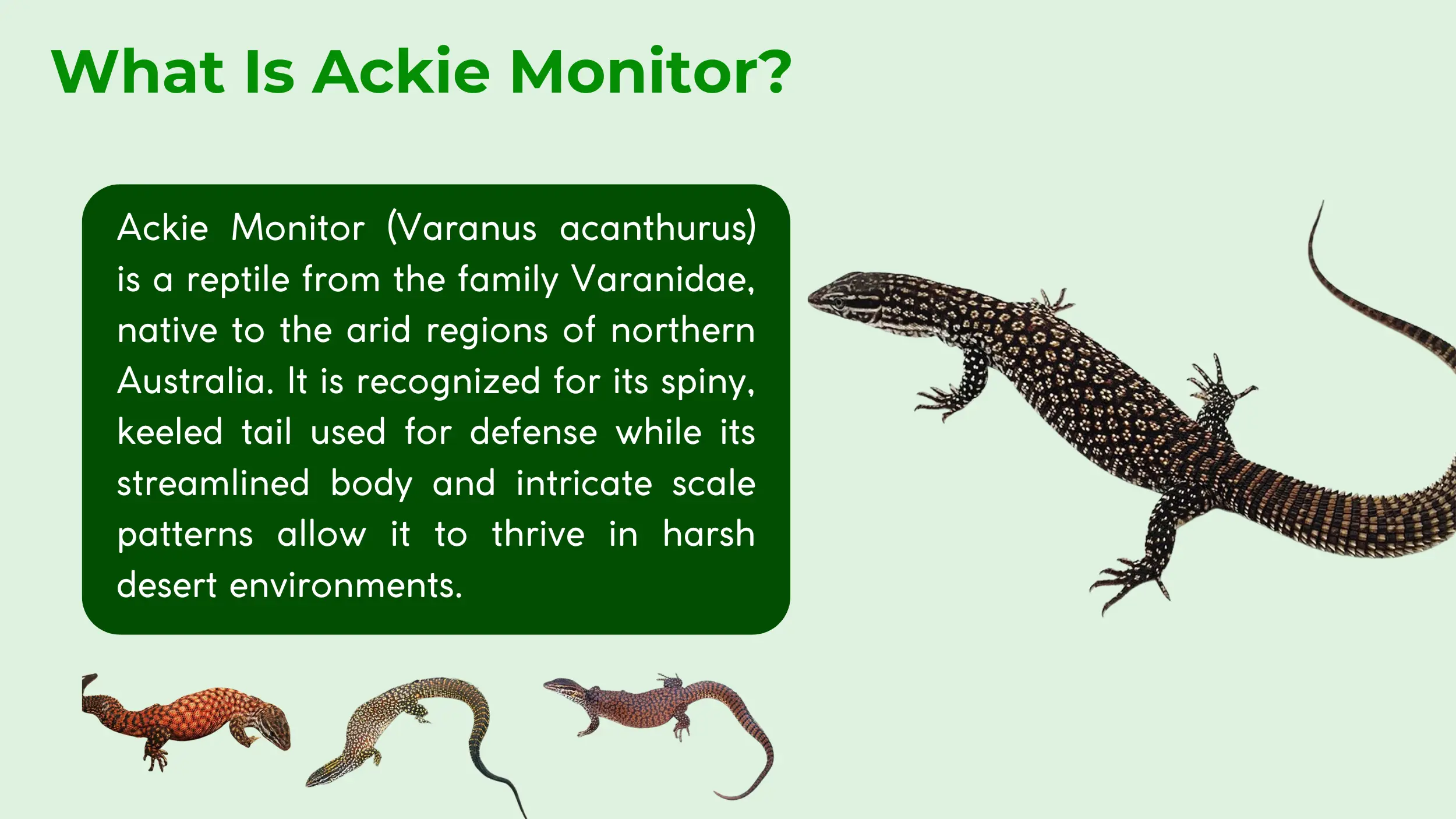
What Does an Ackie Monitor Look Like?
The Ackie monitor possesses a slender, somewhat rounded physique with a streamlined form, which is an adaptation for its semi-fossorial lifestyle in rocky habitats [8]. Its body is covered in an intricate mosaic of small, smooth scales.
The upper side is a dark brown, contrasted by bright yellowish to cream spots, or ocelli, that provide effective camouflage against the arid landscape [7, 9]. This intricate pattern of coloration facilitates thermoregulation and predator avoidance, enabling the lizard to blend seamlessly with its environment.
The species possesses a number of distinctive features. These include its pointed head, keen eyes, forked tongue, short limbs, and its namesake spiny tail [8, 3].
- Pointed Head and Facial Features: The head is tapered with a long snout. Its eyes are a moderate size with dark brown irises and round pupils. A nictitating membrane, a translucent third eyelid, protects the eyes from debris while foraging [7]. The nostrils are slit-like and positioned midway on the snout, allowing for a keen sense of smell.
- Specialized Limbs: The monitor has four short, sturdy limbs ending in sharp claws. These limbs are not just for walking; they are primarily used for digging burrows and climbing rocks [8]. Their strength and form are a direct adaptation to the species’ lifestyle, providing the tools necessary for shelter and locomotion in its native habitat.
- Unique Spiny Tail: The tail is perhaps the most defining physical trait, being long and rounded, and covered in heavily keeled, spiny scales [7]. These scales are arranged in alternating rings, which allows the tail to be used for balance and defense. The lizard can whip its tail at predators or, uniquely, wedge it into a rock crevice to block entry, functioning as a “natural door” [9].
- Forked Tongue for Chemoreception: Like other monitor lizards, the Ackie monitor possesses a forked tongue which it flicks to sample the air [8]. This process transfers chemical particles to the Jacobson’s organ on the roof of its mouth, providing a detailed map of its surroundings. This sensory ability is vital for detecting prey and identifying the presence of predators or rivals.
- Exceptional Eyesight: The monitor’s eyesight is highly developed and adapted for hunting [3]. They have a wide field of vision and can detect subtle movements of small prey, such as insects and small rodents, even from a distance. Their vision is a key component of their predatory behavior and survival.
- Thermoregulation via Coloration: The dark coloration on the monitor’s body, especially when contrasted with its lighter spots, helps in thermoregulation [9]. By strategically positioning itself in sunlight, it can rapidly absorb heat to raise its body temperature or seek shade to cool down. This behavioral and physical trait is essential for survival in its hot, arid environment.
Sexual dimorphism is present in the species, though it is subtle and primarily relates to size and head shape [7, 3]. Males are typically larger and have broader, blockier heads compared to the smaller females, which possess narrower heads.
Additionally, males have been noted to have slightly grippier tail scales, a subtle but distinct morphological difference that assists during mating [3].
Understanding the unique physical traits of the Ackie monitor sets the stage for a discussion of its size. We will now consider its typical dimensions and growth patterns, revealing how its compact form is perfect for its survival strategy.
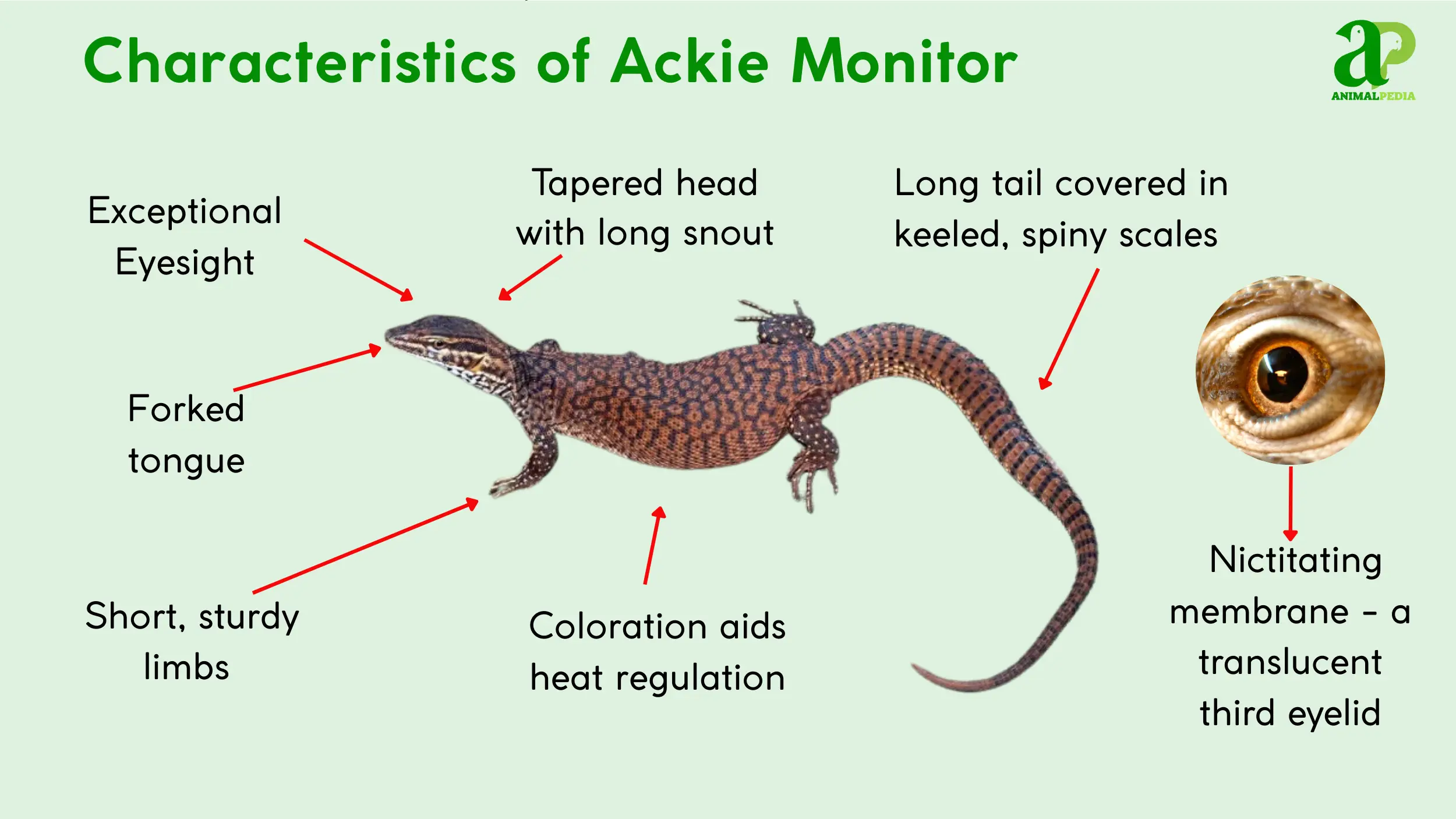
How Big is an Ackie Monitor?
The average total length for an adult Ackie monitor ranges from 24-30 inches (60-75 cm), with the tail making up a significant portion of this measurement [7, 8]. The average adult weight is between 0.44-0.88 pounds (200-400 grams), though this can fluctuate with diet and health [3].
| Male | Female | |
| Length | Up to 30 inches (75 cm) | Up to 24 inches (60 cm) |
| Weight | Often heavier | Lighter build |
| Head | Blockier and broader | Narrower and more tapered |
Ackie monitors undergo distinct growth stages. Hatchlings emerge at a tiny 4-6 inches (10-15 cm) long and weighing only 5-10 grams, roughly the size of a standard ruler [9].
They grow rapidly during their first year, reaching a juvenile size of 12-18 inches (30-45 cm) within 6-12 months. They achieve full maturity within 1-2 years [7, 3]. At their adult size, a 30-inch Ackie monitor is comparable in length to that of a large house cat.
With a firm grasp of the Ackie monitor’s dimensions, we can now turn our attention to its natural habitat. Its size and physical build are perfectly adapted for the challenging landscapes of its native home, where it thrives as a semi-fossorial resident.
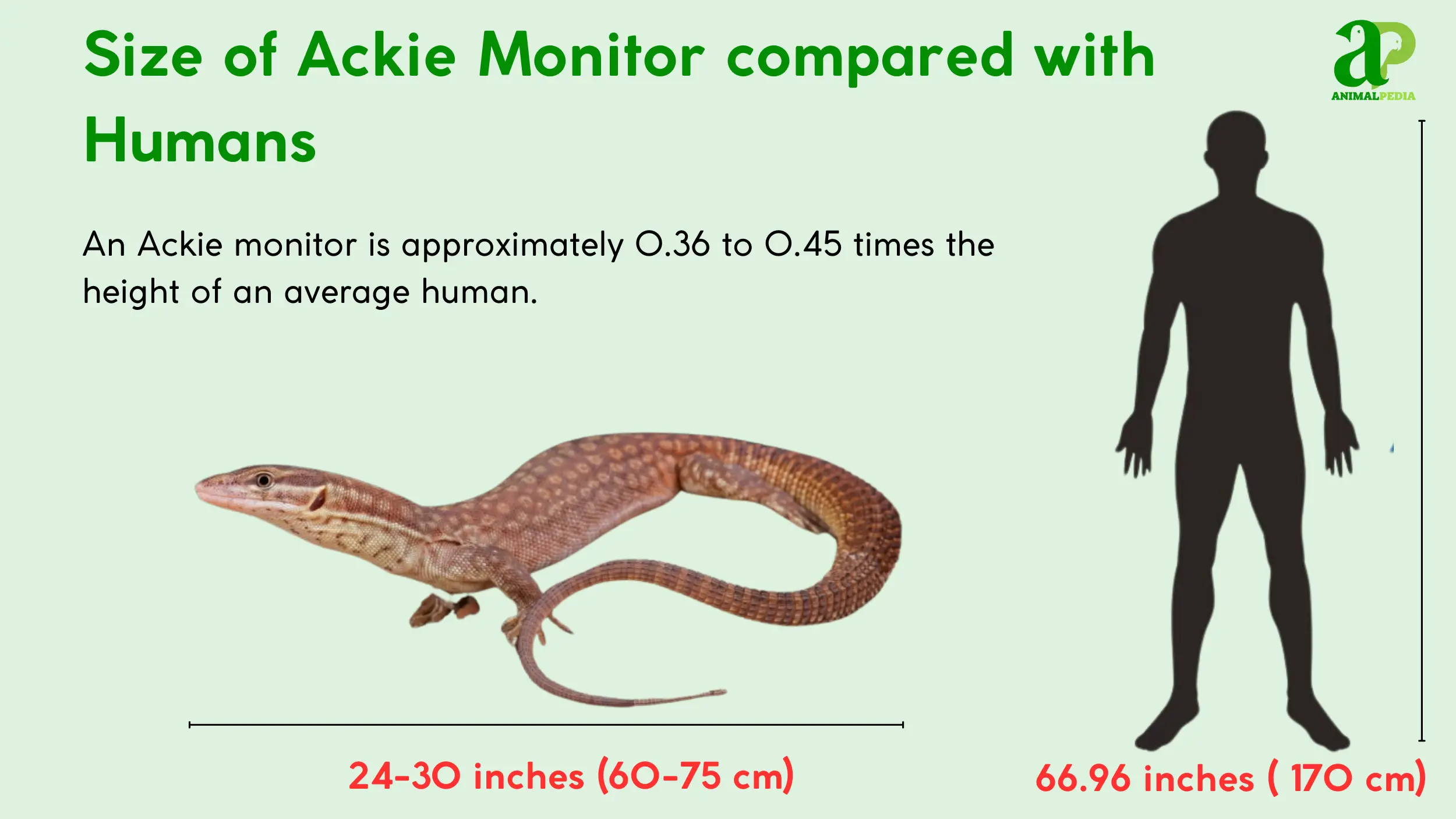
Where Does Ackie Monitor Live?
The Ackie monitor is native to the arid and semi-arid regions of northern Australia, specifically inhabiting parts of Western Australia, the Northern Territory, and Queensland [4, 7]. This species occupies a specialized niche, thriving in rocky outcrops, dry woodlands, and grasslands [4].
These terrestrial environments are characterized by sparse vegetation and an abundance of crevices and burrows, which the monitors use for shelter and thermoregulation. The species is found at various elevations across its range.
The climate requirements are crucial to its survival, as the monitor is adapted to the hot, dry conditions of its habitat. It exhibits a semi-fossorial lifestyle, spending a significant portion of its time in burrows to escape extreme heat and conserve water.
Ackie monitors are solitary animals that maintain a consistent territory. They are not highly territorial towards other lizards but will defend their personal burrows and foraging grounds [3].
Having established the habitat of the Ackie monitor, it’s time to explore how it behaves within this environment. Its daily routines and survival strategies reveal the clever ways this reptile has adapted to its niche.

How Does Ackie Monitor Behave?
The Ackie monitor exhibits a range of behaviors that center on its status as an active, terrestrial predator. Its daily activities are driven by thermoregulation and the search for food, while its interactions with its environment and other animals reflect a highly adapted survival strategy.
- Diet and Feeding: As an opportunistic insectivore, the Ackie monitor actively forages for a diverse array of arthropods, relying on its senses to locate prey.
- Movement and Abilities: The species is highly agile, combining rapid terrestrial sprints with skilled rock climbing and burrowing to navigate its complex habitat.
- Daily/Seasonal Patterns: Ackie monitors are diurnal, with a daily cycle of activity that includes basking, hunting, and retreating to burrows, with seasonal fluctuations in this routine.
By examining its specific behavioral traits, we can gain insight into how this reptile thrives within its unique ecological niche.
Diet and Feeding
The Ackie monitor is an insectivorous species, with its diet consisting primarily of arthropods [3, 7]. Common prey items include beetles, roaches, crickets, and spiders, though it is an opportunistic feeder that will consume any invertebrates it encounters.
The monitor uses a seek-and-destroy hunting method, actively foraging and using its keen sense of smell and eyesight to pinpoint prey [3]. The forked tongue allows it to taste the air, creating a chemical map of its surroundings that guides it to potential food sources.
Once a prey item is located, the monitor uses its speed and powerful bite to quickly subdue it. The Ackie monitor’s diet and feeding patterns are directly linked to its predatory role within its ecosystem.
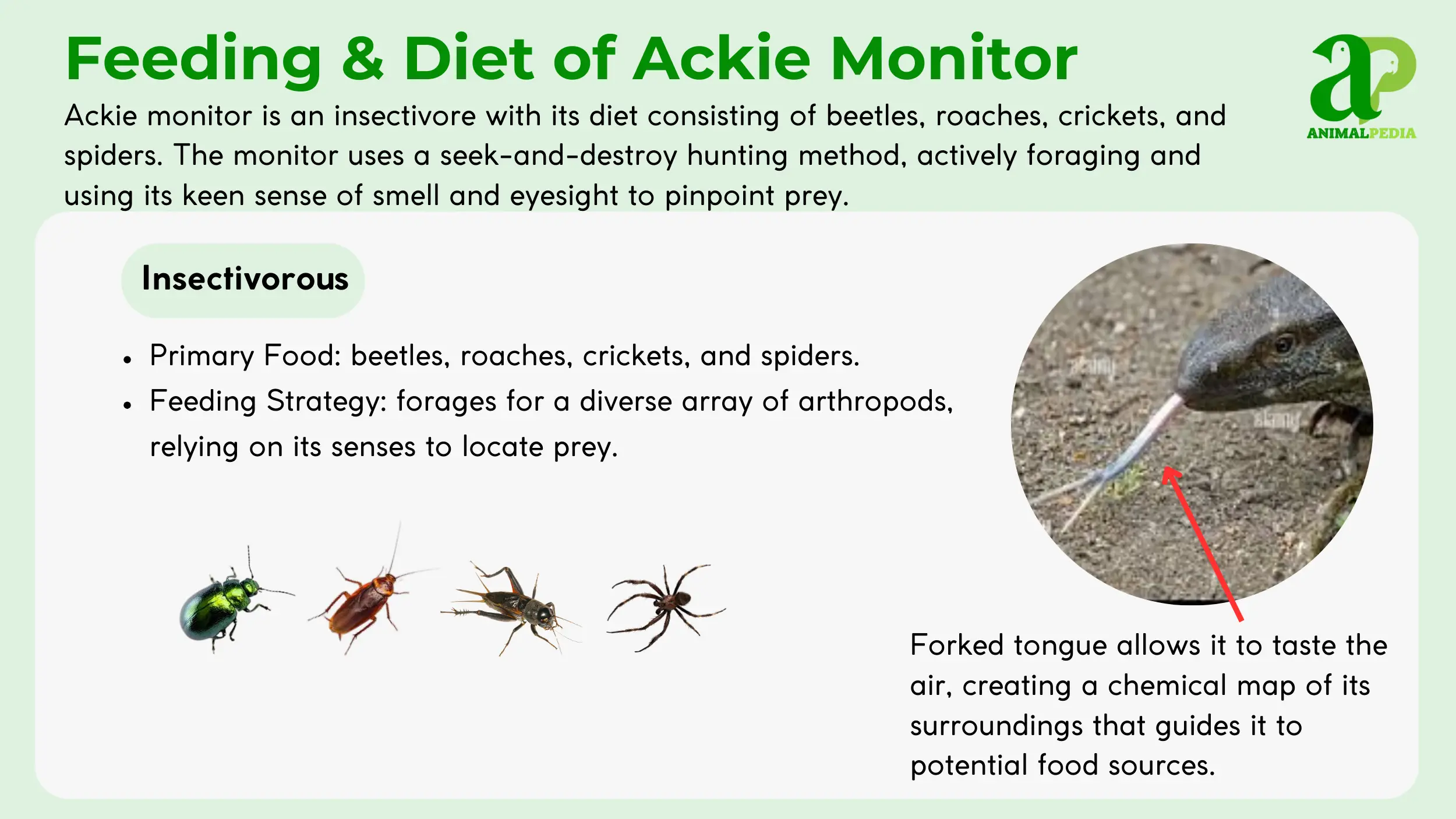
Is Ackie Monitor Venomous?
Recent scientific research indicates that the Ackie monitor, along with other members of the Varanus genus, does possess venom [1]. The venom is not used for defense against humans; instead, it is a low-potency toxin delivered through specialized glands in the lower jaw [1].
When injected into smaller prey, such as insects or rodents, this venom can cause a rapid drop in blood pressure, leading to shock and allowing the monitor to overpower its meal [1].
For humans, an Ackie monitor bite is not medically significant due to the venom, but the bite itself can be painful and cause tissue damage from the lizard’s powerful jaws and sharp teeth [3].
The species’ primary defense against perceived threats is a display of aggression, including hissing, puffing up its body, and a defensive tail whip [7]. Biting is a last resort, and encounters with the species do not require special medical treatment beyond standard wound care.
Movement and Abilities
The Ackie monitor is a highly mobile reptile, exhibiting a combination of terrestrial, climbing, and fossorial movements [8, 9]. Its strong legs and sharp claws are adapted for a scrambling gait over rocky terrain and through dry grasslands.
The tail is used for balance and is a key tool in its agile movements [9]. The species can run at speeds up to 15 kilometers per hour (9.3 miles per hour) for short bursts, primarily to catch prey or evade predators [3].
A key special ability is its burrowing and rock-crevice utilization. Ackie monitors are semi-fossorial, meaning they spend a significant amount of time in burrows that they excavate themselves.
These burrows provide a stable microclimate, protecting the lizard from extreme temperatures and predators [4]. In addition to burrowing, they are capable climbers, using their claws to scale rocks and trees to hunt or find basking spots [3, 8]. This combination of physical capabilities allows the monitor to thrive in its complex environment.
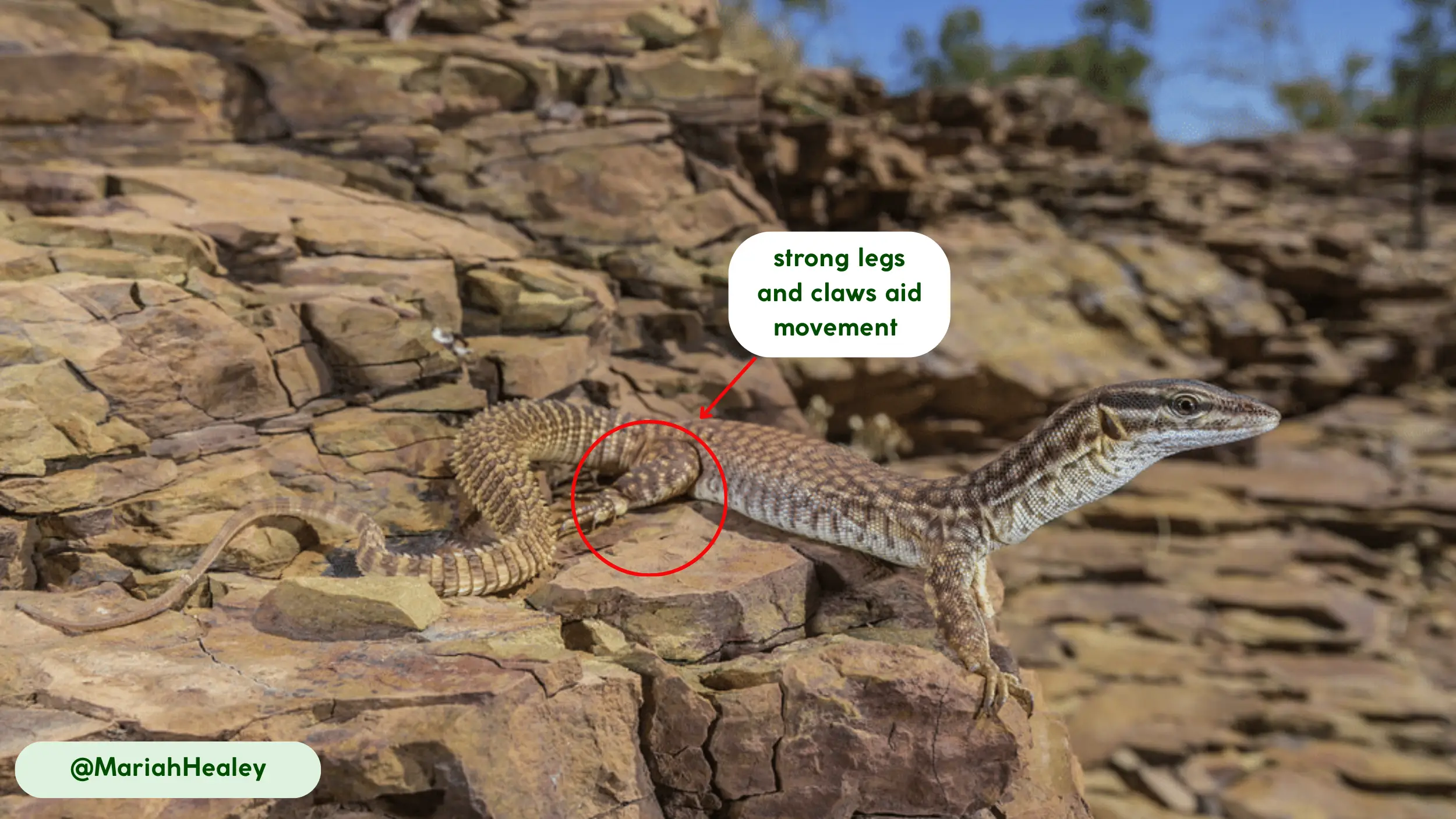
Daily/Seasonal Patterns
The Ackie monitor is a diurnal reptile, with its active period beginning after sunrise and concluding at dusk [3, 7]. Its daily activity cycle is primarily dictated by the need for thermoregulation, and can be broken down into specific time ranges:
- Early Morning (Sunrise – 10:00 AM): The monitor emerges from its burrow to bask, absorbing sunlight to raise its body temperature to an optimal level for activity.
- Midday (10:00 AM – 4:00 PM): This is the peak foraging time. The monitor actively hunts for prey and patrols its territory. It may retreat to the shade or its burrow during the hottest hours to avoid overheating.
- Late Afternoon (4:00 PM – Dusk): The monitor resumes hunting before returning to its burrow for the night.
Activity levels fluctuate with the seasons. Ackie monitors are most active during the warmer, humid months, which coincide with peak food availability and breeding.
During cooler periods, the species enters a state of brumation, a form of dormancy, reducing its metabolism and spending more time sheltered in its burrow [3]. The Ackie monitor does not undertake true migrations; it maintains a consistent territory and moves within its established home range for foraging and shelter.
With a clear understanding of its behavior, let’s explore its reproductive cycle. The methods this reptile uses to reproduce are vital for the continuation of its species, and they are a direct result of its evolution in the Australian ecosystem.
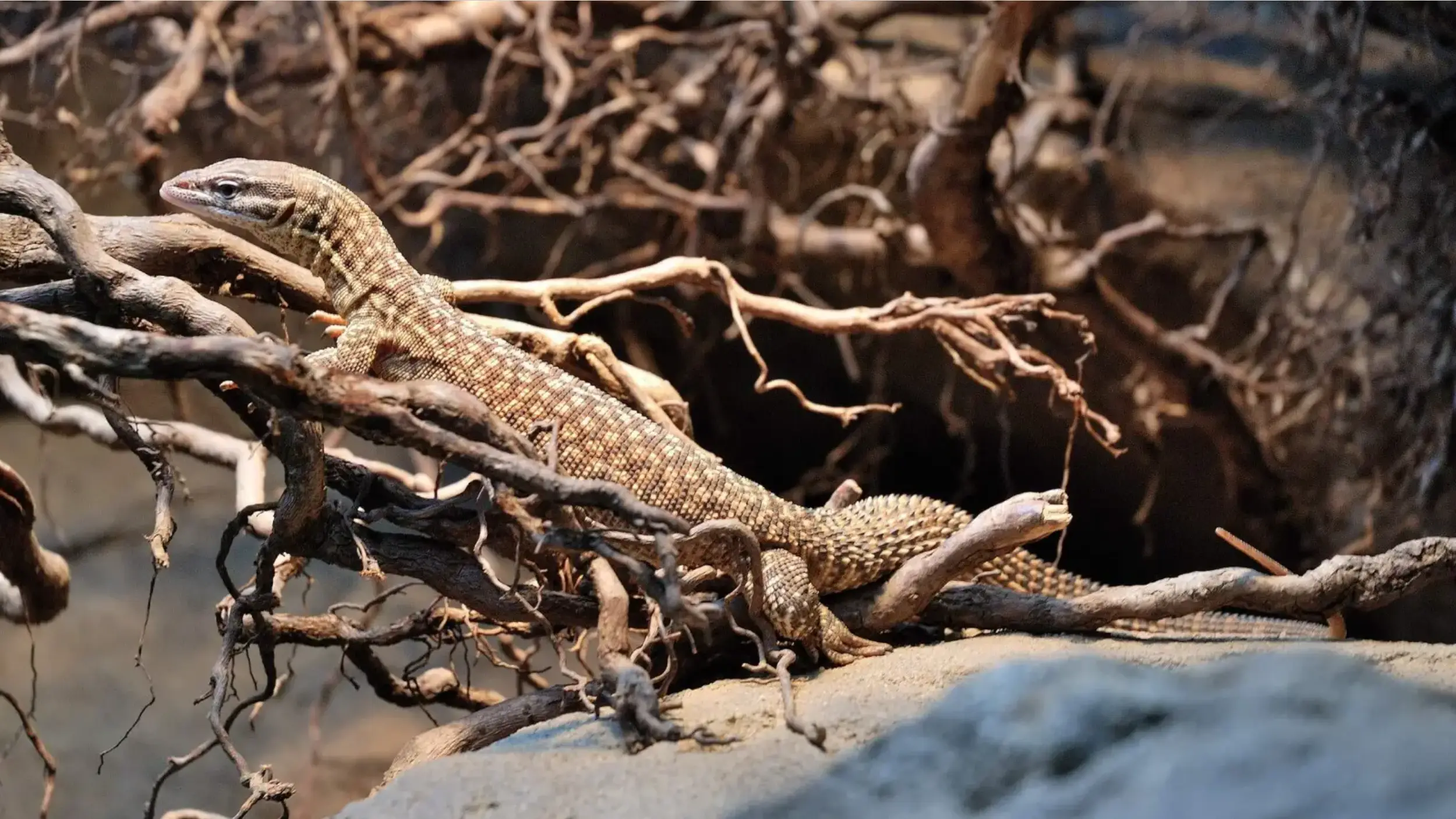
How Does Ackie Monitor Reproduce?
The Ackie monitor is an oviparous species, meaning it reproduces by laying eggs rather than giving live birth [11]. Mating typically occurs in the warmer months of the breeding season, which can span from early spring to late summer [11]. Courtship behaviors include the male approaching the female, engaging in a series of head bobs and tail whips, and potentially subduing her with a gentle neck bite to facilitate copulation.
After a gestation period of approximately one month, the female deposits a clutch of eggs in a nest [11]. Clutch sizes vary, with an average of 6-18 eggs laid per clutch [12]. A single female can produce multiple clutches in a year. The incubation period lasts 3-5 months, after which the hatchlings emerge [12].
Parental care is not a behavior observed in this species, as the hatchlings are independent upon emergence. The timing of breeding is strongly influenced by environmental factors, including temperature and food availability.
The reproductive cycle of the Ackie monitor is a fascinating process that directly impacts its life expectancy. The species’ longevity is influenced by a variety of factors, from environmental conditions in the wild to the controlled care it receives in captivity.
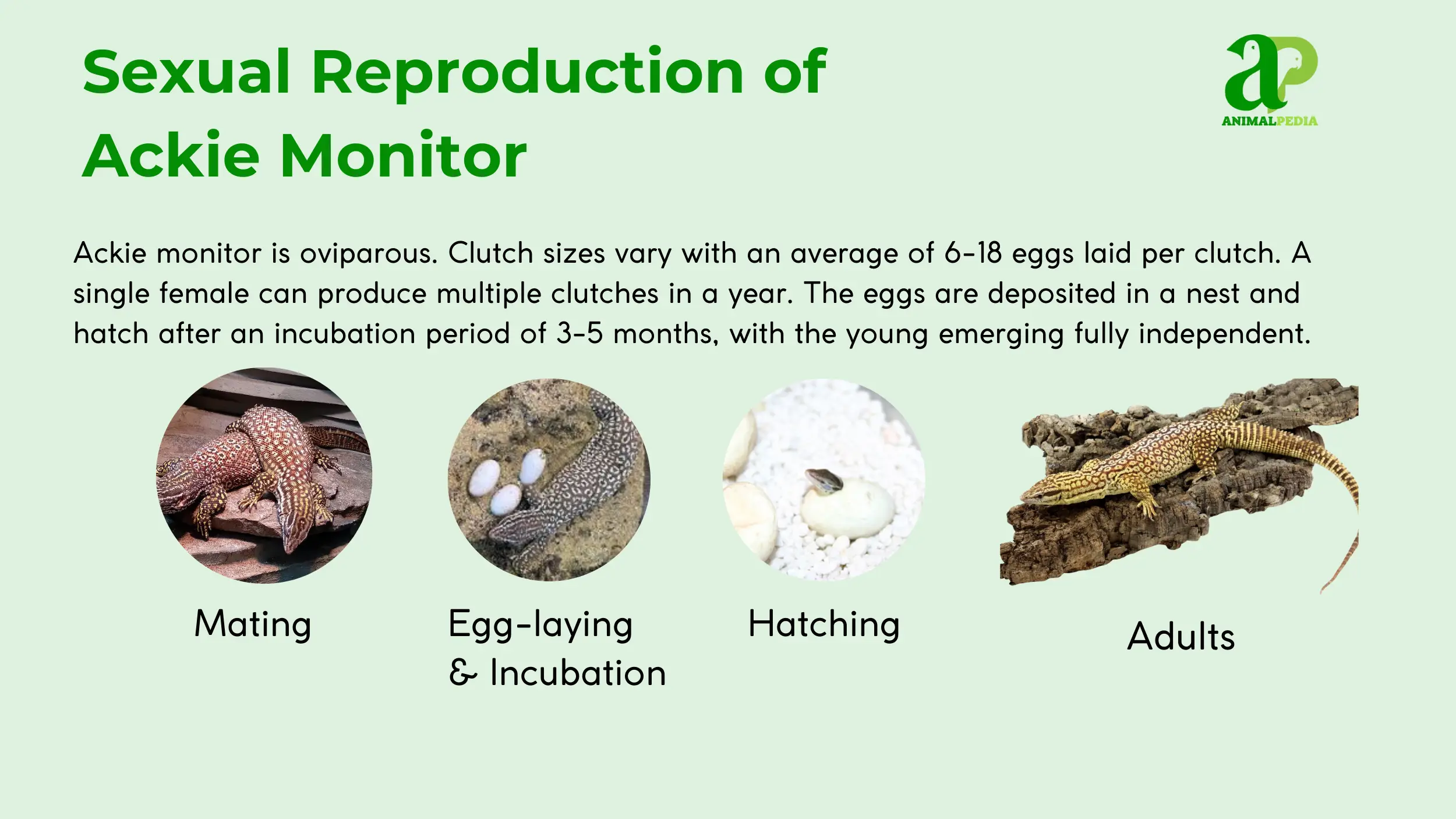
How Long Does Ackie Monitor Live?
An Ackie monitor lives for an average of 15-20 years in captivity, while its lifespan in the wild is considerably shorter [12, 10]. In their native habitat, factors such as predation, food scarcity, and environmental stress contribute to a lower average longevity, often less than 10 years [10].
This species reaches sexual maturity at a young age, typically between 1-2 years old [12]. The main factors affecting a monitor’s lifespan are diet, the quality of its habitat, and the presence of human impact, such as habitat loss and collection for the pet trade [10]. The controlled conditions of captivity, which provide consistent food, a stable climate, and veterinary care, significantly extend its lifespan beyond what is seen in the wild [12].
The Ackie monitor’s lifespan is tied to its role in its ecosystem, which directly benefits other life forms, including humans. Its contribution to environmental balance is a key aspect of its existence that is worth considering.
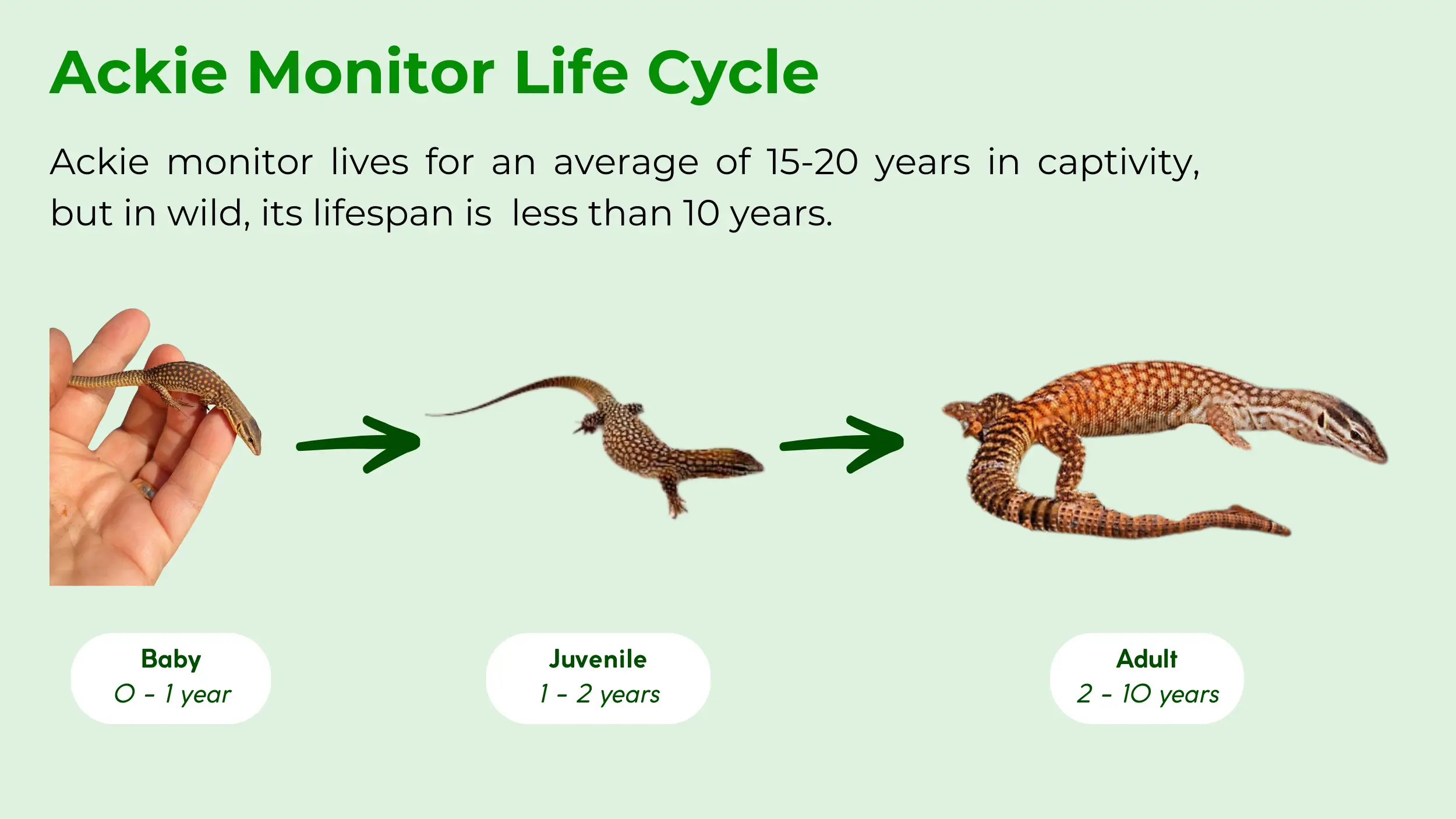
Is Ackie Monitor Beneficial to Humans?
The Ackie monitor is beneficial to humans primarily through its ecological role as a natural pest control agent. As an active, insectivorous predator, the species consumes a high volume of arthropods, including many that are considered pests in agricultural or residential settings [3].
By foraging on beetles, roaches, and other insects, these lizards contribute to maintaining the balance of their local ecosystems, which indirectly benefits human populations by regulating pest insect numbers.
Beyond its ecological function, the species provides scientific and economic value. It is a valuable subject for herpetological research, serving as a model organism for studies on reptile physiology and behavior [1].
Additionally, the Ackie monitor is a popular species within the exotic pet trade, creating a niche market for breeders and suppliers. This commercial activity, when conducted responsibly, can help to reduce pressure on wild populations by providing a sustainable source for enthusiasts.
The Ackie monitor’s benefit to human society is tied to its conservation status. Its ability to serve as a pet and as a subject of research depends on its continued survival in the wild.
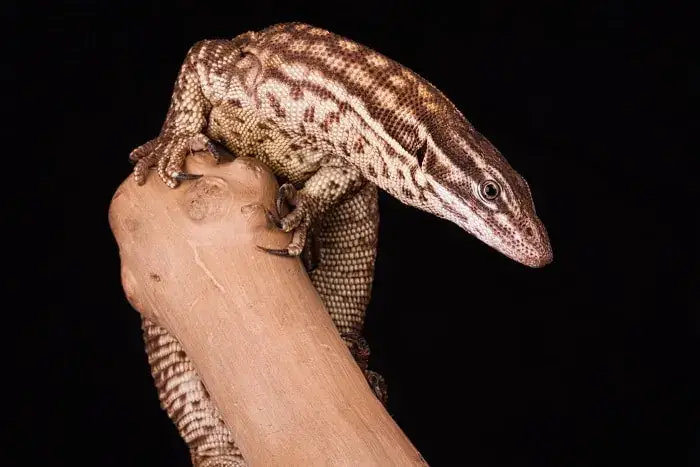
Is the Ackie Monitor Endangered?
The Ackie monitor is not considered endangered and is officially classified as a species of “Least Concern” by the IUCN [2]. This designation indicates that the species is widespread and its population is stable, with a low risk of extinction in the wild.
While the overall population is healthy, localized threats exist due to human activities such as habitat destruction and illegal collection for the pet trade, which can negatively affect certain populations [10].
The species plays an important ecological role as a mesopredator and a food source for larger animals, contributing to the health of its ecosystem [10]. Individuals can help support the species’ continued survival by ensuring that any pet Ackie monitors are acquired from responsible breeders who do not source animals from the wild.
Additionally, supporting habitat conservation initiatives that protect the arid and rocky landscapes of northern Australia contributes directly to the species’ long-term viability.
With its conservation status clarified, we can now turn our attention to some of the more surprising details about this reptile. Its behavior and abilities are full of fascinating facts that challenge common perceptions about lizards.zz
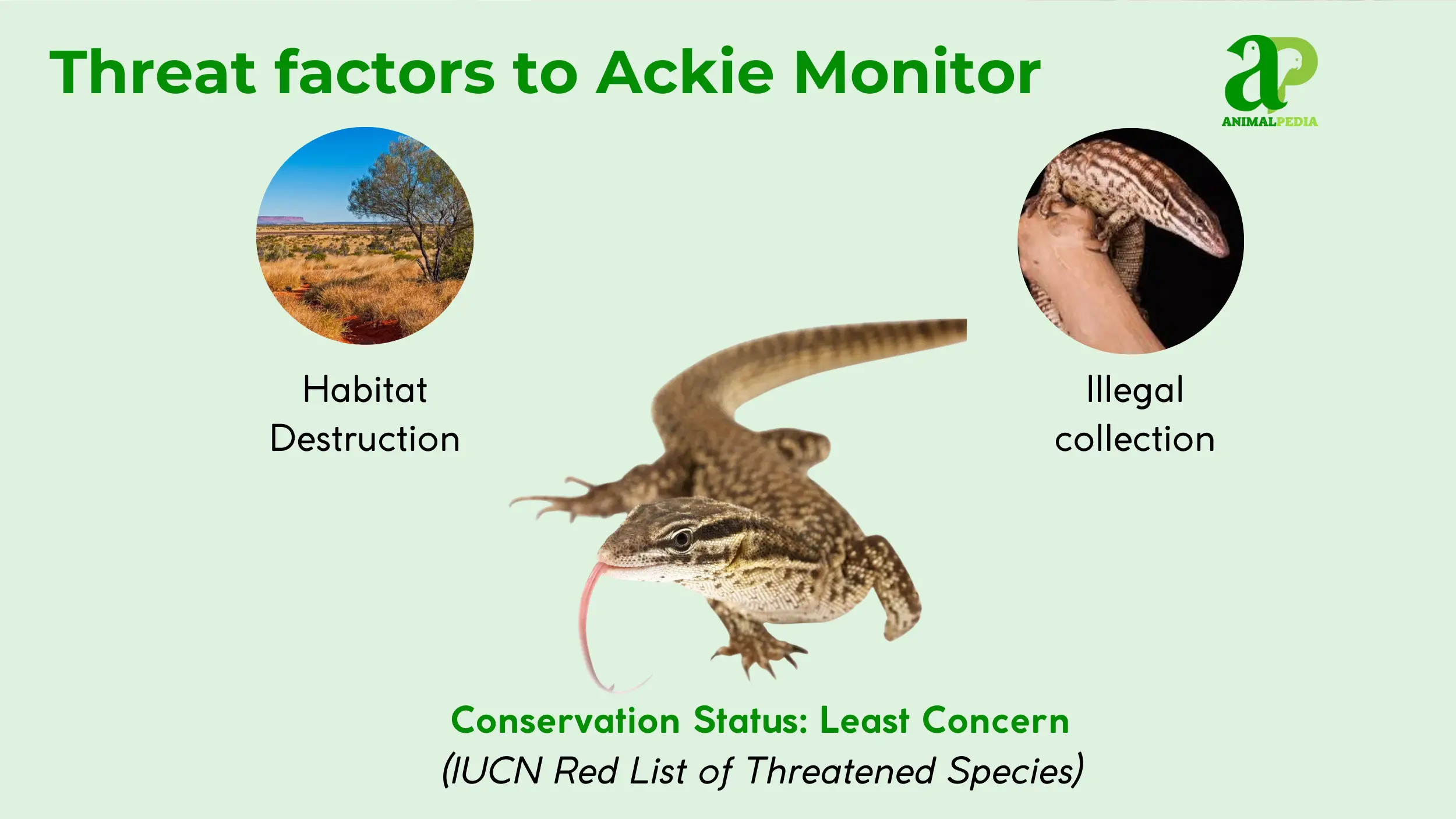
Frequently Asked Questions About Ackie Monitor
Are Ackie Monitors Good Pets?
Yes, Ackie monitors are considered excellent pets for experienced reptile keepers due to their manageable size and generally docile temperament when handled regularly [3, 7]. However, they require a large enclosure and specific heating and lighting to thrive in a home environment.
Can Ackie Monitors Live Together?
No, cohabitation is not recommended for Ackie monitors. They are solitary by nature, and housing them together can result in stress, resource competition, and aggression [7]. Maintaining separate enclosures is the safest approach to ensure their well-being.
Can Ackie Monitors Swim?
Yes, Ackie monitors are capable swimmers, although they are not an aquatic species [7]. Their ability to swim is a vital survival skill, used to cross bodies of water or escape from predators if necessary. They can be observed swimming in rare instances.
Do Ackie Monitors Eat Other Lizards?
Yes, as opportunistic predators, Ackie monitors may consume other small lizards if the opportunity arises. However, their primary diet consists of a wide variety of arthropods, and vertebrates are only an occasional food source [3].
Do Ackie Monitors Have A Parietal Eye?
Yes, the Ackie monitor possesses a parietal eye, or “third eye,” located on the top of its head [6]. This photoreceptive organ helps regulate circadian rhythms and hormone production by detecting changes in light and shadow, aiding in thermoregulation.
What Do Baby Ackie Monitors Eat?
Baby Ackie monitors, or hatchlings, primarily consume small insects, such as pinhead crickets, mealworms, and roaches [7]. Their diet is similar to that of adults, but the size of the prey must be appropriately small to prevent choking.
What Eats Ackie Monitors?
In the wild, Ackie monitors are preyed upon by dingoes, snakes, and large birds of prey due to their small size [10]. Their primary defense mechanisms are their speed and ability to retreat into burrows or rock crevices.
Will A Bearded Dragon And An Ackie Monitor Fight?
Yes, a bearded dragon and an Ackie monitor will almost certainly fight [3]. These species should never be housed together due to the monitor’s predatory nature and the risk of injury or death to the bearded dragon.
Conclusion
The Ackie monitor is a testament to natural adaptation, a small but robust reptile perfectly suited for its arid environment. Its taxonomy reveals its place in a diverse family, while its physical form, with its spiny tail and streamlined body, is a marvel of evolutionary design.
The species’ unique behaviors, from its specialized diet to its semi-fossorial lifestyle, are a result of its role as a diurnal predator. As we have seen, the Ackie monitor is not only a fascinating subject of study but also a species of conservation concern, with its continued survival relying on responsible human actions.
This article has provided a detailed scientific overview of the Ackie monitor. To continue your educational journey into the world of reptiles and beyond, explore more of our expertly curated content on the Animal Pedia website.

